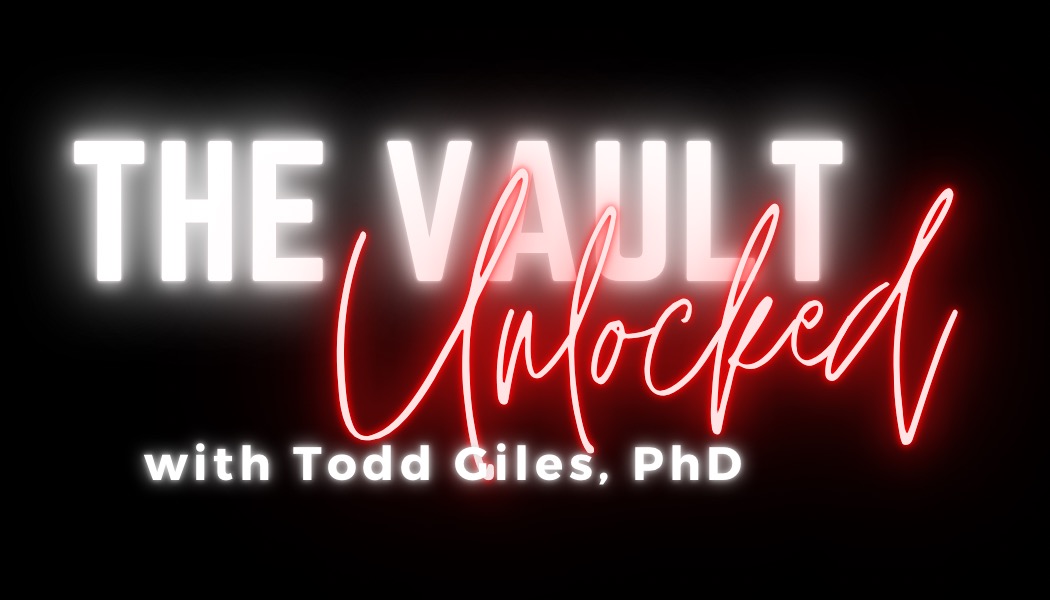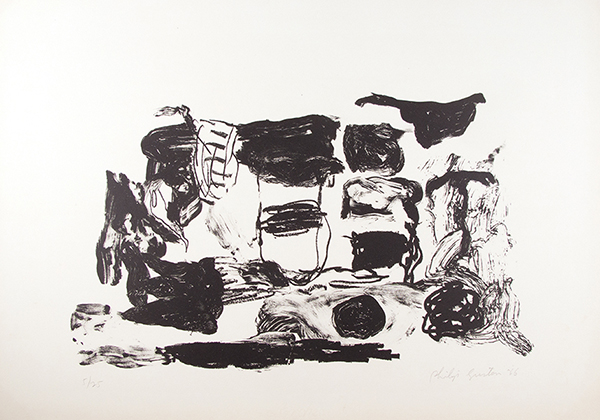
Ever wonder where the art is stored at the WFMA, and what's in there anyway? Join MSU professor Todd Giles as he unlocks the vault!

Philip Guston
Untitled (From Suite of Ten Lithographs), 1966
Lithograph on Rives BFK paper
22 7/16” x 30 1/8”
Signed & dated in pencil
Numbered 5/25
Hollander’s Workshop, Inc., New York
Museum purchase, 1978
“There is something ridiculous and miserly in the myth we inherit from abstract art. That painting is autonomous, pure and for itself, therefore we habitually analyze its ingredients and define its limits. But painting is ‘impure.’ It is the adjustment of 'impurities' which forces its continuity. We are image-makers and image-ridden.”
~ Philip Guston, 1960 (qtd. in Balken 34)
Though Philip Guston (1913–1980) is best known for his grotesque cartoon-like images that include close-ups of gnarly hirsute body parts, worn-out hobnailed shoes, phallic-looking Richard Nixons, and stylized white-sheeted Klansmen, he, like many post-World War II artists, cut his teeth in the 1930s and 40s as a Works Progress Administration painter. As such, his is an aesthetic eye towards the Mexican muralists working at the time such as Diego Rivera and Jose Clemente Orozco, the latter of whom is also represented in the WFMA’s permanent collection.
Guston grew up in the late teens and twenties in Los Angeles, where he became friends with a young Jackson Pollock at the LA Manual Arts High School. The boys, who would later become two of the founders of Abstract Expressionism in New York, were expelled from school for printing a pamphlet opposing the school’s emphasis on sports over art. Radicals at an early age, Guston and Pollock became groundbreakers in art.
In the late 1960s, as was the case earlier with Pollock and others, Guston moved away from abstraction back to his prewar figurative representation, only now in a very different, yet still highly stylized way. As the epigraph above indicates, Guston found the cult of abstraction on somewhat shaky ground because, as he says, we are “image-makers and image-ridden.” This return to the figurative image was believed by friends and art critics alike to sound the death knell of his artistic career. Ironically, though, it’s these disturbingly odd figures for which Guston is most well-known today, not his pure abstractions.
Guston made his first prints at Tamarind Lithography Workshop in LA in 1963, where many of the post-war artists in the WFMA’s permanent collection also worked, such as Sam Francis, Robert Motherwell and Louise Nevelson. At Tamarind, he met Master Printer Irwin Hollander, who invited him to his own printmaking workshop in New York, where Guston produced a suite of nine editions of lithographs, including Suite of Ten Lithographs, of which this work is a part.
Guston’s Hollander Workshop prints were composed with the same spontaneity and gestural action of his earlier abstract paintings, though, as was the case with Motherwell, Guston tended to have already worked out what he was after intellectually, philosophically, and spiritually through the act of drawing. According to art historian David Acton, the prints produced by Guston at Hollander’s hark back to the drawings Guston made in the early 1960s which “teased the boundaries between representation, abstraction, and association” (“Abstract” 14). It is right here—in this liminal space between abstraction and representation—where we find the untitled 1966 lithograph under discussion. As Acton puts it, it’s about the “nonobjective image and the associations it may conjure” (Stamp 236). In this case, a row of jars on a shelf.
At this point in his career, Guston was primarily interested in reproducing what he saw through drawing. As was the case with Pollock’s “black period” in the early 1950s (see Untitled, after Number 9, 1951), Guston likewise abandoned color in his prints to help him better explore form, depth, and surface. And, like our great American author Gertrude Stein’s fascination with how we perceive objects (as seen in her 1914 book Tender Buttons), for Guston perception was not so much about accurate reproduction, but rather thinking about shape, depth, representation, and the physical act of drawing.
So how did Guston grapple with these ideas? By drawing still-life subjects such as rows of jars or piles of fabric and then copying his own drawings, each time reworking shape and line in new ways. By the time he was ready to bring his ideas to the lithographic stone, he was, like classical Japanese Sumi ink painters, operating in the realm of spontaneous becoming. That is, through the act of repetition, the self eventually dissipates and the action becomes the thing itself—think about athletes who talk about being in the zone. According to Hollander, “[G]etting that image out from inside him, it was an act of such a spiritual nature. It was also fast—the gesture that came out, and the line could really describe that. . . . With Guston that was magnificent because the squiggle and the shape and the richness was immediate’” (qtd. in Acton, “Abstract” 14).
Some questions to consider: Is it necessary (or even important) to see jars on a shelf in this lithograph to understand and/or appreciate it? Or to know the background I shared above about its production and the ideas behind it? Not really; not for this viewer anyway. After all, the series within which this untitled lithograph belongs is simply titled Suite of Ten Lithographs, not “Still-lifes” or “Jars” or some such. Likewise—to return to the epigraph above—is it even necessary to “analyze its ingredients and define its limits,” as Guston grouses about the “myth” of abstract art?
To put the question another way, will delving into the elements of the artwork—line, shape, balance, color (or lack thereof), etc.—help us unlock some magical door through which we will arrive at a deeper understanding? I really can’t say, so let me close with a quote from Stein’s Tender Buttons: “The lesson is to learn that it does show it, that it shows it and that nothing, that there is nothing, that there is nothing, that there is no more to do about it and just so much more is there plenty of reason for making an exchange.” For me, the “exchange” is that I am drawn into this artwork anew every time I see it. Drawn in, challenged, and enriched. That is what art and literature is all about. Imagine living in a world in which all of our interactions—whether with other people, animals, plants, art, music, etc.—left us challenged and enriched. What a rewarding world it would be.
Works Consulted
Acton, David. “Abstract Expressionist Prints at Tamarind.” Tamarind: Forty Years. Ed. Marjorie Devon. Albuquerque: U of New Mexico P, 2000. 5-35.
Acton, David. Stamp of Impulse: Abstract Expressionist Prints. MA: Worcester Art Museum, 2001.
Auping, Michael. “Impure Thoughts: On Guston’s Abstractions.” Philip Guston Retrospective. Modern Art Museum of Fort Worth, 2004.
Balken, Debra Bricker, Bill Berkson, et al. Philip Guston’s Poem-Pictures. U of Michigan: Addison Gallery of American Art, 1995.
Untitled from the Permanent Collection of the Wichita Falls Museum of Art at MSU Texas
View Previous The Vault Unlocked
-
Tuesday - Friday
10:00AM - 5:00PMSaturday
1:00PM - 5:00PM